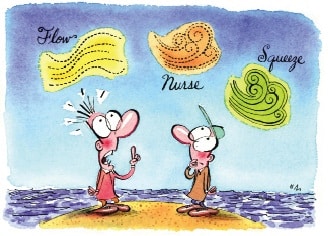
The Lights Go On
ROB: I’ve always wanted to talk to you about this light-air sailing thing. I’ve read all the books …
Doc: … as you often point out …
ROB: … but I just don’t get why some of the authors say you should have full sails in light air, and some say you should have flat sails. How does that work? Surely there’s another way to think about this.
Doc: It can be confusing. How have you been going in the light stuff?
ROB: Actually, we’re quite fast when it’s soft.
Doc: What’s your best thinking on how to set up for those conditions?
ROB: That’s what I’m asking you! I’m getting quite confused.
Doc: Can you think of the last light-air race when you were really fast?
ROB: Yes, two weeks ago in the twilight race. We had Joe sitting in the middle of the boat, and Sue and I were up on the rail. We smoked ‘em up the first beat.
Doc: … and how were you set up?
ROB: Well, the main was quite deep, and I was sheeting it so that the top leech telltale was just flicking—about 50 percent flow. The jib cars were forward, and the leech telltale was streaming, but I was continually telling Joe to sheet on just a little more. He kept giving me this dark look and not really changing anything!
Doc: So you were sailing in “squeeze” conditions. There was enough breeze for you to focus on getting as much power as possible out of what was there, without worrying too much about stalling the rig.
ROB: That’s exactly how it was. I was trying to extract as much power as I could, going right up to edge of stalling the sails, but not quite overdoing it, and—hang on, I think you’re saying there are other kinds of light winds? This feels like one of those infomercials, and here comes the “but wait, there’s more” pitch.
Doc: Bingo! I think that single idea, that there are multiple kinds of light air, might be a key to upwind speed in the light. It boils down to the fact that, through the range of breezes we lump under the label “light air,” you make the biggest changes in your rig settings compared to any other conditions. We don’t really notice the big range because we usually only start races in the top of that “light air” band, that is, races usually don’t start unless there’s a reasonably stable breeze of at least 5 knots. But we often end up racing in some real drifters.
ROB: I know what you mean. Three weeks ago, we did a race that started in about 6 or 7 knots but faded to nothing.
Doc: How did you go?
ROB: Initially quite well. But when the breeze died, it was a lottery, and we got badly rolled.
Doc: What was your set up?
ROB: Just our best light-air settings, like I described before, but we didn’t sheet quite as hard, obviously. It was impossible to get the leech ribbons to fly.
Doc: … and those are called “flow” conditions. In that glassy stuff you are trying just about anything to get the breeze to flow around the sails at a time when the wind has almost no energy to do that. So you make it as easy as possible for the breeze to bend around the sail and get all the way to the leech. Compared to squeeze conditions, the sails are flat, particularly the main. The sheeting angles are really wide, and you’re trying to get the sails to sit quietly with a reasonable shape. The woollies are often completely lifeless, and you are tending to sail off the mast-top wind indicator.
ROB: Wouldn’t you also be trying to get lots of twist?
Doc: In those flow conditions the boom is weighing down the leeches, so the leeches won’t twist. That’s why the boom has to be so wide, so the upper leech isn’t so closed, despite the absence of twist. The conditions where you’re looking for twist are “nurse” conditions. You have a little bit of puff, but you have to nurse the boat to make sure that fragile flow doesn’t get broken by “squeezing” too hard.
ROB: Are the differences in the conditions that clear-cut? That explanation seems very simplistic.
Doc: Fair point. You can differentiate them in theory, but on the water you’re often flicking back and forth between the conditions and settings as puffs and lulls roll through. That’s why the adjustments have to change so much and so often.
ROB: So those different light-air settings revolve around three sorts of conditions: flow, when it’s glassy; nurse, when the flow is fragile; and squeeze, when the flow isn’t so fragile, and you’re trying to extract maximum power?
Doc: Exactly, and you set your rig accordingly.
ROB: Squeeze … nurse … flow … even I can remember that.









